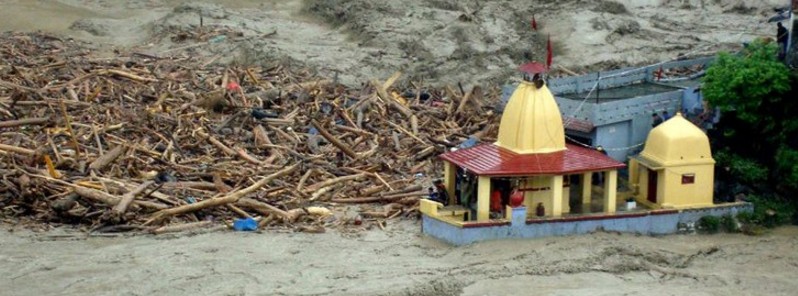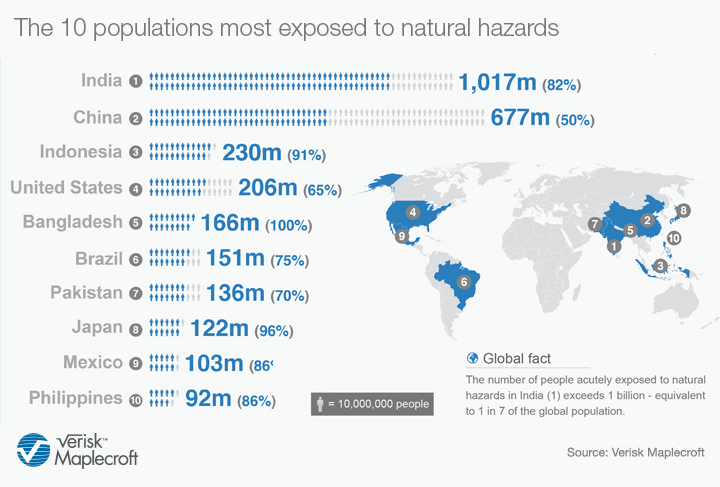1.4 billion people face severe risks in South Asia

According to research released this week by risk analysis and research company Verisk Maplecroft, 1.4 billion people in South Asia, 81% of the region’s population, are acutely exposed to at least one type of natural hazard and live in areas considered to have insufficient resources to cope with and rebound from an extreme event.
The research highlights a lack of resilience to hazards across the region, especially in India, Pakistan and Bangladesh. According to the Bath, UK, based company, these governments have struggled to translate record levels of economic growth into improved resilience against natural hazards, leaving investors open to disruption to economic outputs, risks to business continuity and threats to human capital.
To reach its conclusions, Verisk Maplecroft assessed the risks posed by 11 types of natural hazards, including tropical cyclones, floods, winter storms, earthquakes, wildfires and tsunamis in 20 new risk indices covering 198 countries. The research forms part of its annual Environmental Risk Dataset, which has been developed to help companies identify risks to their assets, personnel and supply chains.
India lags behind the US, China and Japan in capacity to mitigate natural disasters
The populations of 10 countries, including India (ranked 1st), China (2), Bangladesh (3), Indonesia (4), Philippines (5), U.S. (6), Japan (7), Nigeria (8), Brazil (9) and Pakistan (10) are identified by Verisk Maplecroft as facing the greatest exposure to natural hazards in its Natural Hazards Population Exposure Index.
Crucially though, South Asian nations lag behind the world’s leading economies when it comes to mitigating the worst impacts of natural hazards. The company’s Natural Hazards Vulnerability Index, which assesses a country’s ability to prepare for, respond to, and recover from a natural hazard event, rates Japan (183) and the U.S. (173) as ‘low risk,’ and China (126) ‘medium risk’. In comparison, the weaker institutional capacity, financial resources and infrastructure of Bangladesh (37), Pakistan (43) and India (49) mean they are rated ‘high risk,’ leaving companies and populations there under greater threat if a significant event strikes.

Credit: Verisk Maplecroft
The data identifies flooding as one of the most substantial risks to communities and business in South Asia. In India alone, 113 million people, or 9% of the population, are acutely exposed to flood hazard, with a further 76 million exposed in Bangladesh and 10 million in Pakistan. Indeed, heavy monsoon rain in November-December 2015 sparked record flooding in South India, which cost the country upwards of US$3 billion and displaced more than 100,000 people.
In its city-level analysis, Verisk Maplecroft flags the populations of three South Asian cities among the 10 most exposed globally. These include the major garment producer Dhaka in Bangladesh (ranked 5th most exposed) and the rapidly growing tech hubs of Kolkata (6) and Delhi (9) in India. Manila, Philippines (1), Tokyo, Japan (2), Jakarta, Indonesia (3), Dongguan, China (4), Osaka, Japan (7), Mexico City, Mexico (8) and Sao Paolo, Brazil (10) complete the list.
Resilience to natural hazards lowest in Africa and South Asia
“This data highlights the scale of the task facing governments and business in mitigating the threats to populations and workforces from natural hazards in these high-risk regions,” states Dr James Allan, Director of Environment at Verisk Maplecroft. “With overseas investment pouring into the emerging Asian markets, companies have an increasing responsibility to understand their exposure and work with governments to build resilience.”
According to Verisk Maplecroft, poor governance, weak infrastructure and high levels of poverty and corruption amplify the economic and humanitarian losses associated with significant natural hazards events. In the Natural Hazards Vulnerability Index, Africa hosts 8 out of the 9 most vulnerable countries, with South Sudan (1), Burundi (2), Afghanistan (3), Eritrea (4), Chad (5) Niger (6), Sudan (7), Mali (8) and DR Congo (9) all are considered ‘extreme risk’.
Outside of Africa, South Asia is the most vulnerable region. Despite progress in recent years, rapid economic growth is yet to translate into the development of resilience at the community level, including bolstering healthcare and education provision. Additionally, the capacity of these countries’ building stocks to withstand hazards is typically inadequate. This was evident during the April 2015 earthquake in Nepal (31), where a lack of institutional capacity and poor infrastructure contributed to a death toll of more than 9,000 people and left many communities isolated for days afterwards.
Source: Verisk Maplecroft
Featured image: Debris carried by floodwaters of the River Alaknanda crashes against a Hindu Temple in Chamoli district in the northern Indian state of Uttarakhand on June 18, 2013. Credit: The Indian Army

Just think if they didn’t wast all that money and time on the global warming scam they would have plenty of resources to fight natural disasters.
This Poster’s global area of abode, is probably the ‘Safest’ place on the surface of the Globe! Mid-Canada, right on the “Canadian Shield’, – probably the hardest rock, ‘anywhere!”
When the man made disasters are included, which country is the least vulnerable, Bhutan?